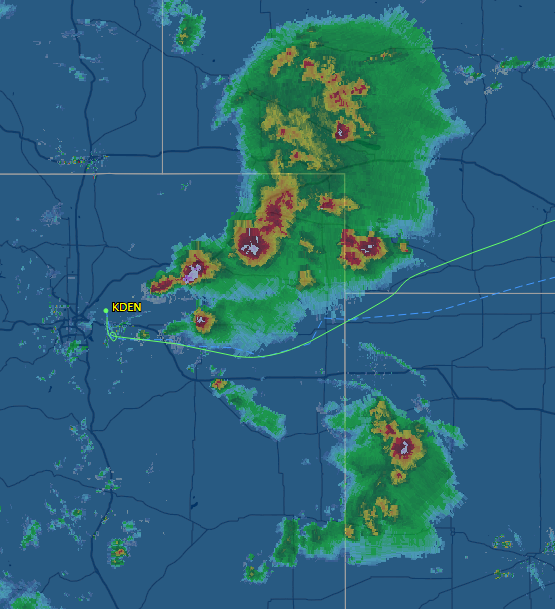A Boston TV station interviewed me regarding Delta 1889, an Airbus A320 scheduled from Boston to Salt Lake City that encountered hail and diverted to Denver. Below is the big picture of NEXRAD data that one can see from a web browser and the plane’s track over the ground. The big picture is available for free to anyone with a web browser. Adding that capability to a little Cessna costs about $10,000 for the FAA-certified XM radio ($100 for a car?) and about $600 per year for the data subscription from XM. How much would it cost to put this $100 XM radio in a Boeing or Airbus? The regulator hurdles are so high that it would almost surely not be affordable to airlines. Therefore they rely on onboard weather radar that can see rain out the front plus advice from air traffic controllers who have at least local NEXRAD data on their radar screens.
Without the big picture the pilots would have had a tough time seeing that the space between thunderstorms was tight (the FAA says don’t get any closer than 20 nautical miles to a thunderstorm for fear of hail and turbulence, but that is just a rule of thumb) and that going south to Oklahoma or north through the top of Kansas would have been more prudent. Their onboard radar reflects wonderfully off rain but not so well from the dry baseball-sized hail that they encountered.
The primitive nature of electronics for aircraft was on full display during this incident. The pilots of Delta 1889 had cracked windshields that could have blown out at any moment, causing a depressurization. Their onboard radar was destroyed. But there was no way for them to have a dedicated communication channel to ATC. The controllers had to keep talking to other airplanes on the party line and giving what attention they could to the airplane with the emergency. (liveatc recording)
The pilots quite sensibly picked Denver, an airport with crazy long runways (one is 16,000′ long!). It is easy to fly any instrument-certified airplane, including an A320, down to about 200′ above the ground without being able to see out the windows. The final 200′ usually requires visual identification of the runway. However, due to their spectacularly foggy/misty weather, the British decided to build autoland systems starting in the 1960s. The typical domestic airline won’t maintain and test autoland to the extent required to make it legal to use day-to-day. Where autoland becomes a factor in the U.S. is for transoceanic flights. With the potential ability to land in fog they can cut down on the amount of reserve fuel that must be carried. However, even if autoland is not maintained and tested all the time it remains available to use and the pilots of Delta 1889 did use it (receiving a “nice job” from the control tower).
The pilots were heroes to everyone (including me, I think, since they sounded so cool on the radio after escaping the hail). But why weren’t the engineers who designed the windshields and the autoland system celebrated? Who went over to France to find the programmer behind the A320 autopilot and autoland system? Who found the glass manufacturer to find out how their product survived the pounding without subjecting passengers to depressurization?


Full post, including comments 
